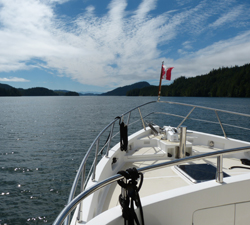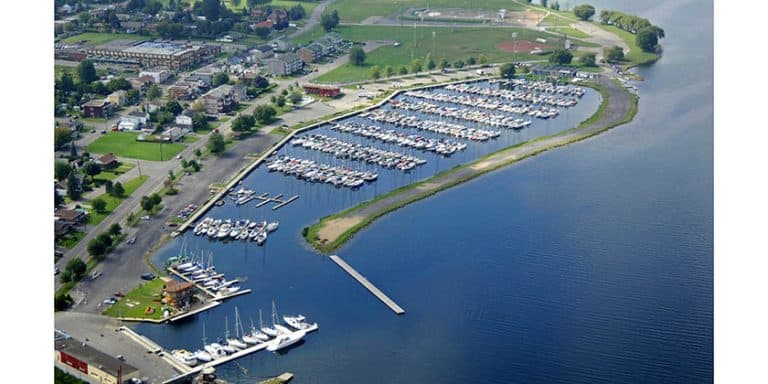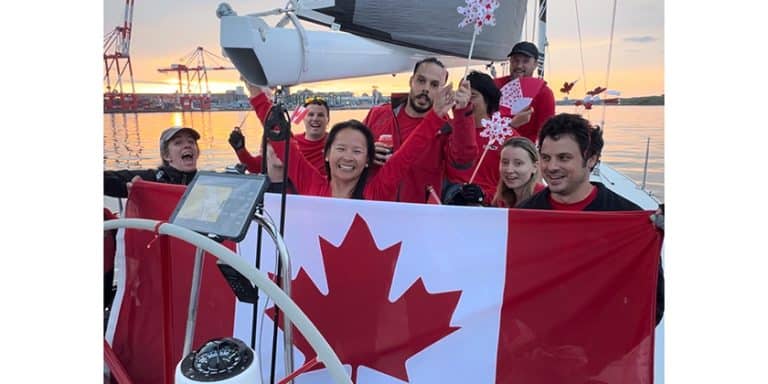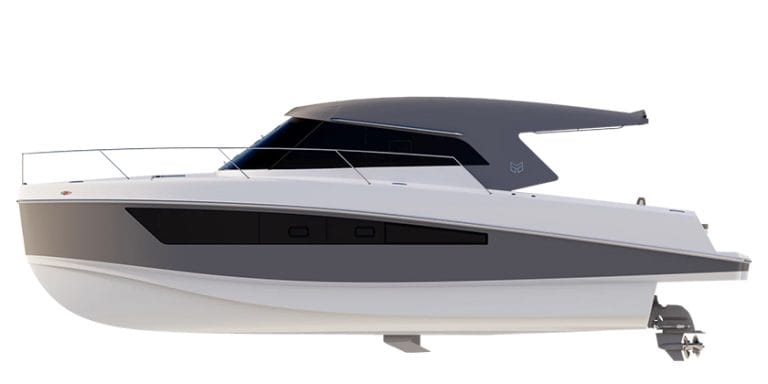Planning Your BIG Adventure Cruise

Planning Your BIG Adventure Cruise
By Mark Bunzel
When it’s time to stretch your cruising range, here’s how to make your big cruise happen.
Have you dreamed of stretching your cruising range from home waters to a legendary destination, chartering in an exotic locale, or cutting shore ties for an extended coastal or offshore passage? An adventure cruise like these can reward you with an unforgettable experience. The rewards may be based on special scenery, a unique or distant destination, skills and confidence gained by stretching your range, or a special event encountered along the way. Your cruise may be special for its length, its challenges and learning opportunities, or the make-up of the crew. Cruising with family, children, grandchildren and even parents can make an adventure cruise special.
Planning
Planning starts with answering a number of questions. Where do you want to go? When do you hope to depart? How long do you plan to cruise? Who will you cruise with? These parameters shape a cruise plan. Your cruise could be to Georgian Bay, the Gulf Islands, Desolation Sound or the North Coast in British Columbia, the Maritimes, or something truly ambitious like the Great Loop, the Intracoastal Waterway or Southeast Alaska. Chartering can extend your choices to the Caribbean, Europe or the South Pacific. Let your imagination run wild – exploring by boat will take you to places that others may never get a chance to see.
 I like to start planning months in advance by developing an overview of my destination from cruising guides and magazine articles. I try to look at different guides for the same area. Authors generally provide good summaries and offer recommended itineraries that can be used as a starting point. Keep in mind that each author brings their unique point of view to cruising in a particular area; from several guides you will get multiple ideas and tips. Some writers may focus on anchoring out, others on destinations with marinas, restaurants, shopping and shoreside attractions. A mix is usually best and you may choose to build your cruise plan around the interests of your crew.
I like to start planning months in advance by developing an overview of my destination from cruising guides and magazine articles. I try to look at different guides for the same area. Authors generally provide good summaries and offer recommended itineraries that can be used as a starting point. Keep in mind that each author brings their unique point of view to cruising in a particular area; from several guides you will get multiple ideas and tips. Some writers may focus on anchoring out, others on destinations with marinas, restaurants, shopping and shoreside attractions. A mix is usually best and you may choose to build your cruise plan around the interests of your crew.
The makeup of your crew may set special parameters: traveling with parents or older friends may call for a less strenuous program or itinerary. And cruising with kids may require different activities and destinations to keep young minds entertained. A long cruise may involve multiple sets of guests and meetings in specific locations on set dates.
 I also like to gather local knowledge: not just the marine or navigation conditions that may affect the cruise but also what may be the best timing to see or experience highlights along the way. Using the Internet, we can research our planned route to discover special events or attractions we may be able to include in our itinerary. You may need to time your cruise in order to see something special or make reservations in advance.
I also like to gather local knowledge: not just the marine or navigation conditions that may affect the cruise but also what may be the best timing to see or experience highlights along the way. Using the Internet, we can research our planned route to discover special events or attractions we may be able to include in our itinerary. You may need to time your cruise in order to see something special or make reservations in advance.
Boat show seminars offer great opportunities to learn from others about destinations or cruising tips. Talk to members of your yacht club or power squadron, as well. Most boaters love to help other boaters. Lots of people have helped me over the years and I view helping others as a means of paying it forward.
Next I start transferring my notes to a spreadsheet. If you are not a computer user, your spreadsheet can be a multiple column list on paper. With a computer spreadsheet you can move lines and edit easily. I use simple calculations to total mileage and multiply the hours per day of cruising or fuel burned. Create a column with a line for each date of your cruise. Add columns for destinations or stopovers, the mileage between them, start time for the day, number of hours underway and planned end time based on your average cruising speed. Allow 15 minutes on either end of the day to leave the dock and account for the typically slower speeds of departure and arrival. Check distance and hours to make sure they allow a reasonable cruising day. A change in current or the need to visit a special place by a certain time may affect your schedule. At this stage your plan will typically show areas where you may need to make adjustments.
 Itinerary
Itinerary
Start looking at your route on charts, a plotter, or navigational software. The pieces will start falling into place. The chart offers a graphical view of your trip. You may realize that there is a town near your intended route with a restaurant you have always wanted to visit, or a special anchorage you’d like to share with your crew.
It’s prudent to add a few weather days on your trip. And remember that pacing a trip realistically can make the difference between a memorable adventure and a rushed passage. You and your crew are on holiday: there is nothing wrong with spending two days or more in one spot. It could offer more time to explore the area, relax or just get the laundry done.
Boating is a very social pastime. You will often meet people on the dock or even walking on a beach – don’t be surprised if they invite you over for a sundowner. Be prepared with items you might want to contribute. Scrumptious cookies, a special appetizer or a bottle of your favourite beverage are all good to bring when you visit. You will meet the most interesting people this way!
Another planning tip: don’t limit yourself to places you can visit only by boat and walk to. Look for travel options for rental cars or vans available at marinas or in towns nearby. Public transportation may be available, and sometimes you can rent bicycles, scooters or kayaks. Getting off the boat and touring can be a refreshing change for all.
 Once you set a preliminary itinerary, tackle the navigational challenges. Look for things along the route that may delay the trip such as tidal rapids, locks or a border crossing. If in doubt, call a local marina. They are ready to help and often very knowledgeable about local waterways and conditions.
Once you set a preliminary itinerary, tackle the navigational challenges. Look for things along the route that may delay the trip such as tidal rapids, locks or a border crossing. If in doubt, call a local marina. They are ready to help and often very knowledgeable about local waterways and conditions.
Share your itinerary with your crew and gauge their reaction. You may think the kids want to see a zoo along the way when they really want to make it to the waterpark. Or you may have your favourite museum, while your cruising partners have another idea. If your crew is located elsewhere, consider a video conference call to discuss the trip. Part of the fun of planning is sharing your excitement with others.
Preparation
Now the work begins. If you are taking your boat on this cruise, allow plenty of time to prepare it for the trip. Work through a checklist of inspections and maintenance. You will likely put significant hours and wear on systems that may see little use for most of the year. Batteries, belts, filters are just a few items that may need attention or replacement. (See sidebar for a checklist I have developed over the years).
 Some dedicated cruisers have firm refit schedules. Belts and hoses are automatically replaced at set intervals. If one battery in the house bank begins to show lower than normal voltage, all house batteries are replaced. Their goal is to take the risk of mechanical failures out of cruising.
Some dedicated cruisers have firm refit schedules. Belts and hoses are automatically replaced at set intervals. If one battery in the house bank begins to show lower than normal voltage, all house batteries are replaced. Their goal is to take the risk of mechanical failures out of cruising.
Compile a spare parts list. Filters, belts, impellers and fuses are all essentials you should have on board, but do you also carry items such as a spare starter, water pump, propeller, and parts for your outboard? Store a spare anchor and rode where it can be quickly deployed. In remote cruising grounds such as BC’s North Coast, you may need to be fairly self-sufficient.
Check your ship’s papers. Is everything up to date? Do you need anything special for a border crossing? Give your guests advance notice of documentation they will need to bring – a missing passport can delay or change a cross-border passage.
 For an extended trip, think through what will need to be taken care of at home in your absence: mail, bills, property monitoring. If you take medications, make sure you have enough for the trip. Pack spare glasses. Think through cameras, electronics, charging systems and all the accessories you depend on in your daily life and make sure you bring them along.
For an extended trip, think through what will need to be taken care of at home in your absence: mail, bills, property monitoring. If you take medications, make sure you have enough for the trip. Pack spare glasses. Think through cameras, electronics, charging systems and all the accessories you depend on in your daily life and make sure you bring them along.
Consider an overnight cruise/sea trial four to six weeks before your trip. This will enable you to test all systems on board including the galley, head and waste systems, as well as your anchoring system. Run your engines at wide-open throttle or, if it is an older engine, at higher than normal RPM for 10 minutes. Use a temperature gun to check your engine temps before and during a high speed run. Check the engine room when cruising at speed for anomalies such as a hot spot on an exhaust elbow or elsewhere in the exhaust system. Are there any leaks? Is your shaft packing gland overly hot? Consider having a qualified mechanic join you to inspect your engine and running gear while under way. It may be a good time to haul the boat, check the hull, intakes and running gear, change anodes and paint the bottom.
Pre-Departure
In the weeks before your departure, it is time to think about loading the boat. We tend to load more than we need for an extended trip, with too much food and provisions and too many clothes. Think carefully about what you take.
When packing, store items in sealable plastic bins. Measure the spaces and openings on your boat and purchase bins to fit. It will be easy to load them at home and stow them on the boat. Then, at the end of the cruise or the season, pack the bins up and take them off the boat. You can also pre-pack many provisions into meal-size bags with all you need to prepare a particular meal (see ‘Planning Easy Meals’).
About a week before departure, start watching weather patterns and prevailing winds. Weather patterns in BC originate in the Pacific Ocean and you can generally follow systems as they move eastward. In Central Canada, systems sweep in from the west and north. Develop a feel for approaching weather patterns and check them around the same time each day. Set limits for you and your crew and don’t be afraid to return to the dock or change your destination if the weather doesn’t cooperate. Getting caught in foul weather can ruin a trip for all and create the wrong kind of memory.
 Consider moving onto your boat the day before departure. This avoids a last-minute effort to stow gear and starts your transition to life on board. A night on board for your guests will ease their transition to life on a boat.
Consider moving onto your boat the day before departure. This avoids a last-minute effort to stow gear and starts your transition to life on board. A night on board for your guests will ease their transition to life on a boat.
Set your daily schedule. Some like to set a time to leave the dock 10 to 15 minutes before they get underway. This works well if you are buddy-boating or in a flotilla. Agree that everyone needs to be off the dock and standing by on the hour, and start your pre-departure routine up to 30 minutes ahead.
Once anchored or moored at the end of the day, review your schedule for the next day, with charts and guidebooks ready. Has anything changed from your original itinerary? I like to look ahead three or four days to determine when I will need fuel and water. This allows me to tighten the itinerary, make changes, or even loosen it up.
Fuel price surveys on the Internet may help you decide where to refuel. My company updates a survey for BC and Washington every two weeks during the summer and monthly during the off-season (fineedge.com/fuelsurvey.html). Many cruisers use it for guidance and call ahead to confirm price or negotiate a volume discount.
 En route, talk to fellow cruisers and marina operators for additional local knowledge. This can include navigational and marine info as well as the hot new restaurant or must-see attraction in town. Your itinerary is just a guideline. Explore and you will be surprised at what you find.
En route, talk to fellow cruisers and marina operators for additional local knowledge. This can include navigational and marine info as well as the hot new restaurant or must-see attraction in town. Your itinerary is just a guideline. Explore and you will be surprised at what you find.
The goal of an adventure cruise should be the safety and enjoyment of crew and captain. Plan carefully and be flexible when under way. Take time to look out the windows and enjoy. There are few things more memorable and rewarding than sharing time on the water with family and friends.
Mark Bunzel is a nautical publisher and writer located in Nanaimo, BC and Anacortes, Washington. He is editor of the annual Waggoner Cruising Guide covering the Inside Passage. He is also co-writer of Cruising the Virgin Islands, the bestselling guidebook to this area. Each year he plans two or three adventure cruises for himself and flotilla groups in the Northwest and other areas of the world.
Big Cruising Adventures
East
Georgian Bay-North Channel – Ontario’s fabled freshwater cruising ground, a paradise of islands and clear water at the north end of Lake Huron.
www.visitgeorgianbay.com/water-based-cruising.cfm
Trent-Severn Waterway – The scenic route from Lake Ontario to Georgian Bay, nearly 400 km across Ontario via rivers, lakes and man-made waterways.
www.pc.gc.ca/eng/lhn-nhs/on/trentsevern/index.aspx
Canadian Maritimes-Down East Loop – From fresh water to salt via the St. Lawrence River, Gulf of St. Lawrence and Atlantic Provinces. Make a loop out of it and return via New England, New York City and upstate waterways.
www.yachtpilot.ca/route.html
Great Loop – An epic cruise around eastern North America, from the Great Lakes south through the big rivers of the United States and north along the Intracoastal Waterway.
www.greatloop.org/index.php
West
Desolation Sound – BC’s best-known cruising ground and a magnet for many at the top of the Strait of Georgia.
www.env.gov.bc.ca/bcparks/explore/parkpgs/desolation/
Broughton Archipelago – For those seeking more of a challenge and quieter waters, some of BC’s best cruising lies “North of Desolation.”
www.env.gov.bc.ca/bcparks/explore/parkpgs/broughton/
Around Vancouver Island – A trip for the adventurous, with challenges inside and outside the island, and a wild beauty that its fans never tire of.
www.bcboatnet.org/around_van_isle.pdf
Southeast Alaska – The Big One for serious West Coast cruisers, north along the Inside Passage to experience the big waters, glaciers and wildlife of “Southeast.”
www.alaska.com/inside-passage/
PHOTOS
Photo 1: The channels of BC’s Inside Passage offer many opportunities for extended cruising in sheltered waters. Duart Snow
Photo 2: Rebecca Spit is a scenic and popular marine park near Desolation Sound. Jan Snow
Photo 3: A good cruise plan will mix beautiful anchorages with fun marina destinations. Mark Bunzel
Photo 4: Unusual sights along the Intracoastal Waterway include this cable car crossing that links linking two parts of a golf course. Mark Bunzel
Photo 5: MoonGlow. The Sam Devlin-designed Moonglow passes Phillips Arm on a cruise to Southeast Alaska. Mark Bunzel
Photo 6: At anchor in the Octopus Islands, north of Desolation Sound. Duart Snow
Photo 7: Returning from a run ashore at Echo Bay. John Jamieson
Photo 8: Snug on a mooring at Georgian Bay’s Cave Island. John Jamieson
Photo 9: Locking Through. Cruisers wait to transit a lock on Ontario’s Trent-Severn Waterway.





























